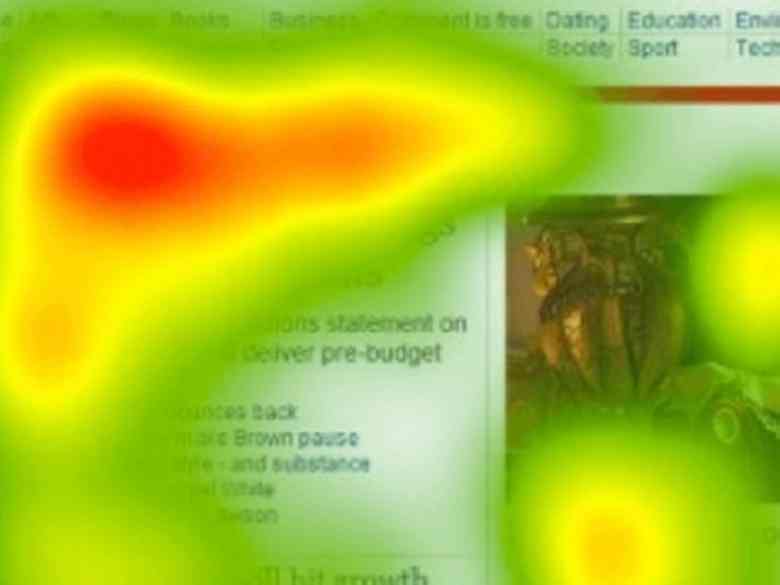Google Analytics is a strong, free net analytics platform. Nevertheless, it has gaps which can be higher served by different instruments. I’ll deal with these gaps and instruments on this submit.
Gaps in Google Analytics
Heatmaps. Google Analytics used to have fundamental warmth mapping capabilities. It does report the most well-liked hyperlinks on a web page (at Conduct > Web site Content material > All Pages > [select page] > Navigation Abstract). However different distributors, reminiscent of Loopy Egg, are higher at offering graphic-rich heatmaps.
Heatmaps present customer conduct on an internet site. This screenshot is from Loopy Egg.
Buyer session recordings. Viewing a consumer’s session as if you’re trying over his shoulder can reveal how that consumer interacts along with your web site and might determine, for instance, why consumers drop out of the path-to-purchase funnel. Google Analytics can not document classes for playback, however different distributors, reminiscent of Inspectlet, specialize on this service.
Inspectlet can document a customer’s session for subsequent playback.
Dashboard reporting. Google Analytics affords knowledge customization capabilities, even some dashboard options, however there are limitations on how the information might be offered. The visible enchantment of dashboards in Google Analytics is weak. Different options do a greater job. One highly effective instance is Knowledge Studio, which Google launched from beta two years in the past.
Knowledge Studio allows wealthy dashboard studies. It integrates with Google Analytics, which makes assembling these studies a lot simpler. The next report in Knowledge Studio is customizable for any on-line retailer.
Retailers can put together customized dashboards in Google Knowledge Studio, which integrates with Analytics.
I addressed Google Knowledge Studio earlier this yr, at “Google Knowledge Studio: Observe Gross sales, ROI from All Sources.”
Reporting on the consumer degree. Google Analytics studies at an combination degree, reminiscent of by marketing campaign, key phrase, and geolocation. Google prohibits the reporting of personally identifiable info — i.e., title, e-mail deal with, telephone quantity. Different choices, nevertheless, report web site engagement and ecommerce exercise by nameless consumer. An instance is Piwik Professional.
Piwik Professional studies web site engagement and exercise by nameless consumer.
Social media reporting. Google Analytics can observe guests to a service provider’s web site from social media. Nevertheless it can not report social media engagement. If you would like insights on, say, likes on Fb, impressions on Instagram, followers on Pinterest, or engagement on Twitter, use a devoted social-media-reporting platform, reminiscent of Sprout Social.
Devoted platforms reminiscent of Sprout Social report social media engagement.
Sprout Social Instance Social Media Report
Alternatively, use third-party connectors for the social media networks in Google Knowledge Studio.
Gross sales from on-line marketplaces. Marketplaces reminiscent of Amazon, eBay, and Walmart don’t permit Google Analytics tags. Thus retailers should depend on studies from these platforms or from third-party options, reminiscent of, once more, Knowledge Studio connectors.
Many “connectors” hyperlink Google Knowledge Studio to third-party platforms.
Telephone-order gross sales. Monitoring phone gross sales is difficult. Google Adverts affords name reporting, which shows a dynamic telephone quantity on a Google Advert or perhaps a web site to trace these calls. However Google Adverts can not observe the substance of the decision, reminiscent of whether or not it was a lead, a sale, or a customer-service question.
To report offline gross sales, a service provider ought to place the order on the web site on behalf of the shopper (so it’s tracked in Google Analytics) or import these offline gross sales into Google Analytics. I addressed the subject final yr, at “Measuring Offline Gross sales in Google Analytics.”


